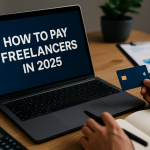Why Invoicing Matters More Than Ever for Freelancers
In 2025, the freelancing economy is more globalized and competitive than ever before. Getting paid on time is not just about sending an invoice – it is about creating trust, maintaining professionalism, and ensuring your business remains financially stable. Poor invoicing practices can result in delayed payments, client disputes, and even lost income.
Common Mistakes Freelancers Make with Invoices
- Not using a consistent invoice template
- Failing to include detailed payment terms
- Sending invoices late
- Not clarifying preferred payment methods
- Ignoring follow-ups when payments are overdue
Avoiding these mistakes can significantly reduce the risk of non-payment and improve client relationships.
Essential Elements of a Professional Invoice
Your invoice should act as both a legal document and a professional representation of your brand. At a minimum, it should include:
- Full name or business name with logo (if applicable)
- Invoice number and date
- Client’s full name and contact details
- Clear description of services rendered
- Total amount due (with currency specified)
- Payment methods accepted (Payoneer, Wise, PayPal, bank transfer, crypto, etc.)
- Payment deadline (e.g., Net 7, Net 14, Net 30)
- Late payment penalty terms (if applicable)
Best Practices to Get Paid Faster
1. Send Invoices Promptly
Don’t wait until the end of the month. Send your invoice immediately after the work is completed or at milestones if the project is large.
2. Use Professional Invoicing Software
Tools like Payoneer Billing, FreshBooks, or QuickBooks automate reminders, generate PDF invoices, and accept multiple currencies. Using professional tools shows clients you take business seriously.
3. Set Clear Payment Terms
Avoid vague deadlines. Instead of saying “due soon,” use “Payment due within 14 days (Net 14).” This reduces ambiguity and excuses for delays.
4. Offer Multiple Payment Options
The easier you make it for clients to pay, the faster you’ll get paid. Accept bank transfers, debit/credit cards, Payoneer, Wise, and even crypto if relevant to your industry.
5. Automate Reminders
Instead of chasing clients manually, set up automated email reminders at 3 days before the due date, on the due date, and 7 days overdue.
Invoicing Tools Popular Among Freelancers
- Payoneer Billing Service – Send invoices directly to international clients and receive payments globally.
- Wise Business – Ideal for multi-currency invoicing with low conversion fees.
- FreshBooks – Great for freelancers managing multiple projects and recurring clients.
- QuickBooks – Suitable for freelancers who also need bookkeeping and tax reports.
- Zoho Invoice – Free invoicing tool for freelancers starting out.
Legal and Tax Considerations
Invoices are not just about payment – they are also financial records. Keep digital copies of all invoices for at least 5 years. In many jurisdictions, proper invoicing is required for tax deductions and compliance. Using platforms like Payoneer also provides official transaction records, which can be used in case of disputes.
Freelancers & Payoneer: A Smart Combo
One of the fastest ways to ensure smooth invoicing and payments is through Payoneer. The platform not only lets you send invoices but also ensures fast and secure global transfers. Sign up for Payoneer to make your invoicing more professional and get paid faster by international clients.
Final Thoughts
Invoicing is the backbone of freelancer cash flow. By using best practices, adopting automation, and working with trusted platforms, freelancers can minimize delays and focus on their core work instead of chasing payments.
Disclosure: This article contains affiliate links. We may earn a commission if you sign up for Payoneer via our link, at no extra cost to you.





